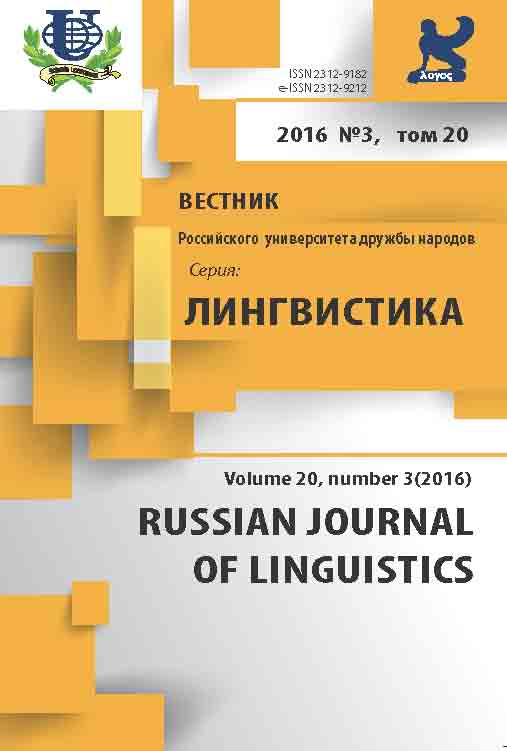The Juror’s Image of an Entertainment TV-Show (on the basis of “The Voice” Show)
- Authors: Gerasimova A.S.1, Issers O.S.1
-
Affiliations:
- F.M. Dostoevsky Omsk State University
- Issue: Vol 20, No 3 (2016)
- Pages: 117-131
- Section: Articles
- URL: https://journals.rudn.ru/linguistics/article/view/14744
Cite item
Full Text
Abstract
The article is devoted to the peculiarities of a public discourse and communicative characteristics of the juror’s image in a creative TV-show «The Voice». Nowadays TV-show has become a popular entertaining program where the image of the juror is not only a pragmatic component of public communication but an element creating the plot of the program as well. Based on the material of oral statements in 40 speech situations, the research defines verbal and non-verbal dominants of Russian communicative behavior while assessing (means of lexical expression, speech tactics, gestures, mimicry and manners) which form a universal image of a tutor throughout a creative TV-show. Being quite new for Russian television, such entertaining format creates a necessity of describing role peculiarities expanding the idea of Russian communicative behavior in conditions of public vicarious communication. To find out verbal and non-verbal correlates of the juror’s role such phenomena as «image» аnd «lingvocultural type» are compared in the article. Theoretical basis of the study was formed due to works of Russian and foreign researchers devoted to image-making and public relations (I.L. Vikent'ev, G.G. Pochepsov, A.P. Fedorkina, V.M. Shepel', P. Bird, J. Fiske, E. Sampson, P. Seitel) as well as works in the sphere of lingvopersonology and cognitive linguistics (O.A. Dmitrieva, V.I. Karasik, V.P. Neroznak, R. Jackendoff, V. Evans, D. Geeraerts). Functional and semantic complexity of a TV-discourse in its genre of a show determined the usage of general description methods, methods of interpretation, generalization and classification. Among some particular the methods of communicative, discourse, structural and semantic analysis were used. In result the study shows that image characteristics are formed not only thanks to the individual peculiarities of the juror’s communicative behavior, but also due to general elements - musical education, sphere of communication, interests etc. These generalized characteristics make it possible to differentiate a lingvocultural type «TV-project tutor» which is notable for its specific cultural speech behavior. The concept «lingvocultural type» becomes a generalized, multivariate, and objective phenomenon. However, in its reduced variant it turns into image.
Keywords
About the authors
Anastasia Sergeevna Gerasimova
F.M. Dostoevsky Omsk State University
Email: staisy_1009@mail.ru
55, Prospect Mira Str., 644077, Omsk, Russia
Oksana Sergeeva Issers
F.M. Dostoevsky Omsk State University
Email: isserso@mail.ru
55, Prospect Mira Str., 644077, Omsk, Russia
References
- Акопов А.И. Средства массовой информации. М., 1990
- Вартанова Е.Л. Медиасистема в России. М.: Аспект Пресс, 2015
- Викентьев И.Л. Приемы рекламы и public relations. СПб.: Триз-Шанс и Бизнес-пресса, 2001
- Дмитриева О.А. Лингвокультурные типажи России и Франции XIX века. Волгоград: 2007. С. 6
- Ермакова О.П., Земская Е.А., Розина Р.И. Слова, с которыми мы все встречались: толковый словарь русского общего жаргона. М.: Азбуковник, 1999
- Егорова-Гантман Е.В., Плешаков К.В. Политическая реклама. М.: Никколо-Медиа, 2002
- Жмыриков А.Н. Психология политического лидерства в современной России. Н. Новгород: Нижегор. гуманитар., центр, 1996
- Засурский, Я.Н. Основные понятия теории журналистики. М., 2003
- Карасик В.И., Дмитриева О.А. Лингвокультурный типаж: к определению понятия // Аксиологическая лингвистика: лингвокультурные типажи: сб. науч. тр. / Под ред. В.И. Карасика. Волгоград: Парадигма, 2005. С. 8-20
- Мацумото Д. Человек, культура, психология. Удивительные загадки, исследования, открытия. СПб.: Прайм Еврознак, 2008
- Нерознак В.П. Лингвистическая персонология: к определению статуса дисциплины // Сб. науч. тр. Моск. гос. лингв. ун-та. Язык. Поэтика. Перевод. М., 1996. № 426. С. 112-116
- Почепцов Г.Г. Профессия: имиджмейкер. СПб.: Алетейя, 2001
- Прохоров Ю.Е., Стернин И.А. Русские: коммуникативное поведение. М.: Флинта, 2006
- Солганик Г.Я. Язык массовой и межличностной коммуникации. М., 2007
- Стернин И.А. О понятии коммуникативного поведения // Kommunikativ-funktionale Sprachbetrachtung. Halle, 1989. С. 279-282
- Стернин И.А. Коммуникативное поведение в структуре национальной культуры // Этнокультурная специфика языкового сознания. М.: Наука, 1996. С. 97-112
- Ученова В.В., Старых Н.В. История рекламы. СПб.: Питер, 2002
- Шепель В.М. Имиджелогия. Секреты личного обаяния. М., 1994
- Шпалинский В.В. Психология менеджмента: учебное пособие. М.: Изд-во УРАО, 2000
- Федоркина А.П. Проблемы имиджа в контексте социального психоанализа / Под ред. А.П. Федоркина, Р.Ф. Ромашкина // Имидж госслужбы. М.: АТС, 1996
- Bird, P. (1994). Sell Yourself. Persuasive Tactics to Boost Your Image. London
- Castells, M. (2001). The Internet Galaxy. Reflections on the Internet, Business and Society. Oxford: University Press
- Evans, V. (2006). Cognitive linguistics. Edinburgh: University Press
- Fiske, J. (1992). Understanding popular culture. London etc
- Fiske, J., Hartley, J. Reading television. London etc., 1978
- Geeraerts, D. (2006). Cognitive linguistics: basic readings. Berlin, New-York: Mouton de Gruyter
- Jackendoff, R. (2007). Language, consciousness, culture: essays on mental structure. USA
- Knapp, M.L., Daly, J.A. (2010). Editors’ introduction: Interpersonal communication. In M.L. Knapp & J.A. Daly (Eds.), Interpersonal communication, volume 1: Introduction, history and communicator characteristics (pp. 21-33). Los Angeles: Sage
- McLuhan, M. Understanding media: the extensions of man. Cambridge: The MIT Press
- Overall, N.C., Sibley, C.G., Travaglia, L.K. Loyal but ignored: The benefits and costs of constructive communication behavior. Personal Relationships. Printed in the United States of America, 127-148
- Sampson, E. (1994). The image factor. A guide to effective self-presentation for career enhancement. London
- Seitel, P.P. (1992). The practice of public relations. New York etc
- Webster, F. (2002). Theories of the Information Society. London, New York
- West, R., Turner, L.H. (2000). Introducing communication theory: Analysis and application. Mountain View, CA: Mayfield

















